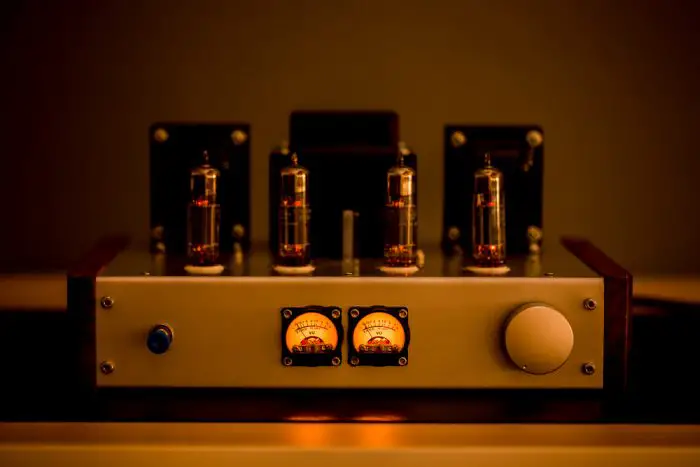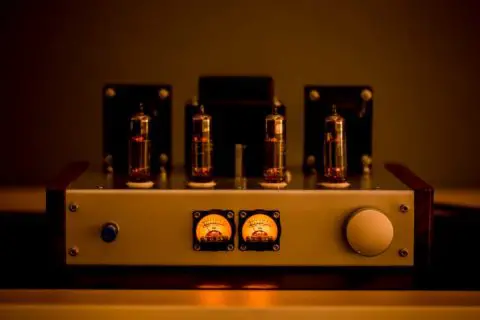There are many ways to find yourself with an vacuum tube that has loose sockets. It usually doesn’t cause huge problems at first, which is why a lot of players may ignore it at first. But, give it some time, and problems start flying out left and right.
But worry no more! Today, I’ll provide you with a thorough guide about tightening tube sockets and keeping them clean and maintained. Let’s dive in!

What Are Tube Sockets?
Before heading into the guide, you should understand what tube sockets are and where you can find them in your amplifier.
Tube sockets are a special type of electrical sockets that are specifically designed to hold on vacuum tubes of the amplifier. They provide a special terminal that you can plug these electronic valves into.
Inside, each one of the terminals is soldered into a circuit for all the tube pins. These sockets are designed to let you insert the vacuum tubes in one orientation.
Despite that, sockets aren’t universal. You can find different tube sockets in different amplifiers. Additionally, different tubes may be able to fit into the same socket. However, even if they fit properly, they might not work as they should and get internal damage.
Almost all kinds of electronic tubes and valves use these sockets to ensure tight hold, easy plugging, and quick removal.
The Structure of a Tube Socket
Although there are different tube sockets with different structures, most of them have a similar layout structure.
The vast majority of tube sockets have a circular disk chassis. This body has the holes where the pins from the vacuum tubes are introduced to the electric circuit. Inside, they contact a circular clamp to deliver electric current.
These holes vary in thickness. Also, the number of holes and their pattern depends on the type of vacuum tube you’re going to use in the system. Usually, the tube sockets are soldered to a metal edge with a screw hole in it to keep them in place.
How Do They Get Loose with Time?
The number one culprit for a loose tube socket is time itself. Even if you use the amplifier tubes properly and plug them with great care, the sockets might start to get a bit wiggly with time.
However, you shouldn’t be worried about that, as that might take many years to happen. Instead, the actual loss of grip occurs when you keep inserting and removing vacuum tubes.
All kinds of vacuum tubes have a lifespan that doesn’t last for long. So, when you replace these tubes, you keep plugging them in and out. This frequent pressure loosens the tight grip of the sockets with time.
Additionally, not all tube pins are the same. Some pins are fatter than the others. I’m talking about a 0.01 of an inch difference. This might not sound like a lot. However, this tiny difference is enough to stretch and push the clamp that contacts the pins away.
As a result, you might find that your vacuum tube is a bit unstable compared to the previous one. Sometimes, this might be a part of the tube’s construction with the pins having a tight grip. In that case, you don’t have to worry about them.
What Are the Effects of a Loose and Dirty Tube Socket?
Having a loose or dirty tube socket can be a huge problem if you don’t act upon it. Unfortunately, most players decide to take action when the sockets are extremely loose. You can avoid all that If you keep a regular schedule of maintenance for your tube amplifiers.
Whether it’s a rectifier, power, or preamp tube, having a loose connection on their pins will cause all kinds of funky stuff when the amplifier is on.
Also, a loose socket can cause leaks of air and debris into the metal pins. As a result, the pins might get tarnished, which worsens the problem even more.
A loose socket might produce random crackling noises and pops even when the amplifier is sitting standby. You can even test this out on a readout screen if you hook it on a soundtracking window on your computer and watch the tube making all sorts of pops and snaps.
Additionally, the amp tubes might sound a lot scratchier and produce a wide variety of low-quality tunes even while playing. This can affect the quality of the music significantly.
The worst that can happen is that it can cause some type of insufficient connection. This leads to anything from random volume drops and thin sounds all the way to complete loss of power.
Things You Need to Do Before the Maintenance Process
Now that you know the problems that might face you with a loose tube socket, it’s time to get ready for the maintenance. As I said, you can avoid most of these problems if you carry out a checkup or a maintenance session regularly.
Before heading into the process of cleaning and re-tensioning your sockets, there are some things that you need to get sorted out first. Let’s have a quick overview of each one of them.
Make a Visual and Audible Inspection
As a rule of thumb, if your tube socket doesn’t need a retightening, you shouldn’t do one. Some players claim that they re-tension their tube sockets anyway on a regular basis. However, this step might be unnecessary if your amplifier is working fine.
You can do a visual and audible inspection by moving and wiggling the tubes around. If the tubes are gripping the sockets tightly, there’s no need to re-tension the sockets. A good confirmatory test is by hearing no random cracks and pops while leaving the amplifier on.
Things can be pretty messy under the hood, so you have to make sure that you’re doing this for a reason.
Record the Pops and Cracks
Since you’re reading this guide, you probably found some cracks and pops while testing out your tubes. A lot of guitar players like to fix their amplifiers themselves and leave the “techie” option as a last resort if things don’t work out.
If you want to test if things are fixed like a professional, you need to maintain a good record of the problem. This can help you see if you’ve fixed it or not.
To do this, you need to do the following. First, you have to turn on the amplifier and unplug the connecting cable from the front. After that, you need to plug the cable to a speaker in a silent room and keep it on standby.
Once the set is complete, use any recording software to record a sample of the noise you got from just sitting around. This can give you a visual reference, as the pops and cracks will show as random peaks of noise.
Unplug the Amplifier and Remove All the Tubes
Whether you’re going to clean or tighten the tube sockets, you’ll have to remove your tubes from the amplifier. You need to remember that tubes have a lot of voltage connected to them. This can cause an electric hazard, which is why you should be careful while removing them.
Also, if you’re following the guide, then you’ve probably just turned it off after a test run in the previous step. In that case, they can be hot to touch.
That’s why you shouldn’t touch your tubes with your bare hands. Instead, you can use a paper towel or any dry piece of cloth.
Before you remove the tubes you need to make sure that you’ve unplugged the amplifier from the wall electricity.
Make sure that you remove them gently so you don’t bend or break the pins. Also, remember that excessive pressure while plugging in and out will loosen the sockets with time.
Make Sure that there’s No Leaking Voltage
Another important thing you need to make sure about is the voltage in these sockets and pins. The idea behind this safety check is to protect you and the amplifier from high wattage, as you’re going to stick brushes and metal parts in there shortly.
To do this you need to plug in a multimeter. I recommend Neoteck Auto-Ranging Digital Multimeter Multimeter. It gives accurate measurements and comes with various options that you’ll need to test out the tubes if you want.
Discharge the Tube Capacitors
When the amplifier is on, the pins can have up to 600 volts. Even after you unplug the tubes, the capacitors can still store a huge amount of charge in them.
You need to discharge the tube capacitors to avoid getting an electric shock. The process is simple and you can find various tutorials on how to do it.
What Are the Tools Needed for the Maintenance Process?
There are multiple tools to clean and tighten your tube sockets. Here’s a quick look at each one of them, so you can choose the ideal options for you.
Screws
The most important and the only item for tightening tube sockets is the screwdriver. For that, you need a simple flathead jewelers screwdriver.
I recommend Foxnovo Precision Flat Blade Slotted Screw Driver. They’re inexpensive but work flawlessly with a good grip and high durability.
Cleaning Brushes
Brushes are among the best tools for the cleaning process. Anything that can fit inside the holes with a bristle-based structure can clean the sockets properly.
For example, you can use the 1/16-inch tube cleaner to clean the insides. However, the nylon bristles might get eroded with time.
You can also use dental picks to clean the socket. Some say that stainless steel bristle brushes can also work, but they might be way too rough for the sockets.
Cleaning Solutions
The most popular solutions to clean your tube sockets are the deoxidizing cleaning ones. You can opt for a CAIG Laboratories D100L-25C Contact Cleaner and follow it up with DeoxIT Gold 100% Contact Conditioner.
There are some claims that isopropyl alcohol can also do the trick. However, it won’t match the level of these dedicated contact cleaners.
How to Tighten Tube Sockets Correctly?
Surprisingly enough, tightening the tube sockets is the simplest part of the entire process. It’s a straightforward process that requires one simple tool.
The loosening occurs when the circular clamps that contact the tubes are pushed further from the center of the tube socket.
To tighten the tube socket, you only need to reverse this process. Simply insert the precision screwdriver into the hole of the tube socket and look for the circular clamp.
All you have to do is push their circular clamps back towards the center part of the tube socket. This will provide the pins of the tube with a snug fit the next time they contact the socket.
However, you need to make sure that you give enough space for the pins to fit within the socket. If you get the clamps to close to the center, they might prevent the pins from fitting inside. If that happens, simply push the clams a little bit and it’ll work.
Once you’re put everything back together, give the amplifier a test run. A good measure here is to compare the new standby noises with the old one. If the loose tube sockets were the culprits, you should witness a huge improvement!
How to Clean the Tube Sockets?
Before tightening the sockets, you can also use the brushes or dental picks to give the sockets a quick clean. Simply dip the brush of your choice in the cleaning solution and insert it into the holes.
Scrub the sockets in a clockwise movement and also up and down a couple of times for each hole. The preamp sockets usually require the smallest brush but you can clean them the same way.
After finishing with the Contact Cleaner, repeat the step with the Gold 100% Contact Conditioner. This gives you maximum efficiency and sound quality.
How to Prevent the Sockets from Getting Loose Again?
It’s impossible to entirely prevent the sockets from getting loose with time. However, you can prolong the need to re-tighten the tube sockets.
Simply, make sure that you make a gentle insertion while putting the tubes back in by reducing the amount of rotation you need to do.
Moreover, try to avoid introducing the tube pins in the wrong angle. The ideal one is a full perpendicular insertion.
Wrap Up
There you have it. A complete guide with everything you need to know about tightening tube sockets and maintaining them in a good condition.
Once again, tube sockets and amps carry a lot of electrical dangers. You should be extremely careful while dealing with them or get professional help to stay safe.
For more resources about retensioning your vacuum tube sockets, here are some links I hope you find helpful:
- Broken Guide Pins from tubeforamps.com
- How To Install A Power Tube With A Broken Guide Key from thetubestore.com
- Retubing Guitar Amps from bustedgear.com
- Bad Tube Socket – symptons and cure from diyaudio.com
- Diagnosing Tube Problems from diamondamplification.com
- How To Tell If Your Tube Is Bad from thetubestore.com
- Five Tips To Perk Up Your Tube Amp from mojotone.com
- How To Test Vacuum Tubes from wikihow.com


